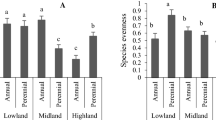Abstract
Grasslands were phytosociologically studied in the lowlands of North Korea. They are represented mainly by Lawns in parks and recreation centres. Two new plant communities were distinguished: the associationDigitario ciliaris-Zoysietum japonicae with many species of the C4 photosynthetic pathway, growing on open sunny habitats and the associationPlantagini asiaticae-Poetum pratensis consisting mostly of species with the C3 photosynthetic pathway and growing on half shaded or moist habitats. Real pastures and meadows are very rare in North Korea. They are analogous to the communities described from Japan.
Similar content being viewed by others
Literature Cited
Al-Khayri J.M., Huang F.H., Thompson L.F. &King J. (1989): In vitro plant regeneration ofZoysia grass.— Arkansas Farm Research, 38: 11.
Anonymus (1979): Flora Coreana. Appendix. Edit. Sci. R.P.D.C., Pyongyang.
Braun-Blanquet J. (1964): Pflanzensoziologie. Grundzüge der Vegetationskunde.—Wien, pp. 865.
Cho N.K. (1986): The plant succession of improved pasture around Mt. Halla in Cheju Island.— Korean J. of Crop Sci. 31: 336–349.
Fukuyama M. &Sinamura M. (1990): Comparisons of underground organs of some short grasses.— J. of Japanese Soc. of Grassland Sci. 36: 39–46.
Henrard J.Th. (1950): Monograph of the genusDigitaria.—Leiden, pp. 999.
Ikeda H., Oyamada M. &Inosaka M. (1984): Analysis of the characteristics ofZoysia japonica strains adapted to warmer regions.— Bull. of the Faculty of Agricult. Miyasaki Univ. 31: 117–122.
Itow S. (1963): Grassland vegetation in uplands of western Honshu, Japan. Part II. Succession and grazing indicators.— Jap. J. Bot. 18: 133–167.
Itow S. (1974): Phytosociological studies on grassland vegetation in western Japan.— Phytocoenologia 1: 306–338.
Kasahara Y. (1982): The agrestal weed flora and vegetation of the world: Japan.—In:Holzner W. & Numata M. [eds.], Biology and ecology of weeds, The Hague, pp. 285–297.
Kawanabe S. (1979): The pattern of temperature response and its ecological significance.—In:Numata M., Ecology of grasslands and bamboolands in the world, Jena, pp. 153–162.
Koyama N. (1989): Energy flow in grazed pastures. V. Effects of vegetation changes on energy flow.— Bull. of the National Grassland Res. Inst. 42: 9–39.
Koyama N., Shiomi M. &Tsuiki M. (1989): Effects of changes in vegetation composition from temperate grasses-dominant to Japanese lawngrass (Zoysia japonica)-dominant on the energy flow in grazing pasture. I. Vegetation changes.— J. of Japanese Soc. of Grassland Sci. 35: 24–29.
Koyama N., Shiyomi M., Tsuiki M., Takahashi S., Akiyama T. &Okubo T. (1986): Energy flow on grazing pasture. III. Effect of botanical composition of pasture plants on energy conversion.— Bull. of the National Grassland Res. Inst. 35: 24–34.
Matumura M. &Nakajima N. (1982): Intraspecific variations in some characters related to seed propagation of Japanese lawn grass. 1. External morphology and fertility of seeds.— Research Bull. of the Faculty of Agricult., Gifu Univ. 46: 365–373.
Matumura M. &Nakajima N. (1984): Intraspecific variations in some characters related to seed propagation of Japanese lawn grass,Zoysia japonica Steud. 2. Seed germinability of preserved clonal lines derived from different localities.— J. of Japanese Soc. of Grassland Sci. 30: 216–223.
Mitamura T., Agata W. &Kamata E. (1984): The characteristics of dry matter production ofZoysia grass and cocksfoot.— Bull. of the National Grassland Res. Inst. 29: 104–116.
Mitamura T., Ogawa Y. &Kamata E. (1982): Studies onZoysia type grassland. III. Effect of soil compaction.— J. of Japanese Soc. of Grassland Sci. 28: 82–88.
Miyawaki A. (1964): Trittgesellschaften auf den Japanischen Inseln.— Bot. Mag. 77: 365–374.
Miyawaki A., Fujiwara K., Suzuki S. & Harada H. (1971): Vegetation der Stadt Fujisawa Kanawaga-Präf.—Eine pflanzensoziologische Studie für die Umweltschutz der Stadt Fujisawa, Fujisawa. (in Japanese with German summary).
Mucina L., Dostálek J., Jarolímek I., Kolbek J. &Ostrý I. (1991): Plant communities of trampled habitats in North Korea.— J. Veget. Sci. 2: 667–678.
Nemoto M. (1982): Weeds of pastures and meadows in Japan.—Holzner W. & Numata M. [eds.], Biology and ecology of weeds, The Hague, pp. 395–401.
Numata M. (1969): Progressive and retrogressive gradient of grassland vegetation measured by degree of succession-ecological judgement of grassland condition and trend IV.— Vegetatio 19: 96–127.
Numata M. (1974): Grassland vegetation.—In:Numata M. [ed.], The flora and vegetation of Japan, Tokyo, pp. 125–149.
Numata M. (1979): Ecology of Grasslands and Bamboolands in the World.-Jena, pp. 299.
Ohwi D. (1965): Flora of Japan.—Washington, pp. 1067.
Okuda T. (1986): Effects of herbivores on the competition of C3 and C4 graminoids.— J. Sci. Hiroshima Univ., Ser. B, Div. 2, 20: 1–27.
Otsuki K., Kawano M., Hosoyamada F., Taniguchi N. &Noda H. (1984): Studies on stability ofZoysia-type grassland.— Bull. of the Shikoku National Agricult. Experiment Station. 44: 158–185.
Puerto A. &Rico M. (1989): Influence of tree canopy (Quercus rotundifolia Lam.) on content in surface soil water in mediterranean grasslands.— Ekológia (ČSSR) 8: 225–238.
Šr⫲tek M. &Kolbek J. (1992): Species structure of artificial grasslands withZoysia japonica Steud. in Pyongyang, North Korea.— Fedd. Rep. 103: 215–234.
Suganuma T. (1966): Phytosociological studies on the semi-natural grasslands used for grazing in Japan I. Classification of grazing land.— Jap. J. Bot. 19: 255–279.
Suganuma (1967): Phytosociological studies on semi-natural grasslands used for grazing in Japan II. Ecological strata in pasture vegetation.— Bot. Mag. 80: 145–160.
Tüxen R. (1979): Zur soziologischen Bearbeitung anthropogener Weide- und Zierrasen europäischer Herkunft in der Holoarktis.—In:Miyawaki A. & Okuda S. [eds.], Vegetation und Landschaft Japans, Yokohama, pp. 45–48.
Tzvelev N.N. (1976): Zlaki SSSR (Poaceae URSS).-Leningrad, pp. 788.
Author information
Authors and Affiliations
Rights and permissions
About this article
Cite this article
Blažková, D. Phytosociological study of grassland vegetation in North Korea. Folia geobot. phytotax. 28, 247–260 (1993). https://doi.org/10.1007/BF02853512
Received:
Accepted:
Issue Date:
DOI: https://doi.org/10.1007/BF02853512




